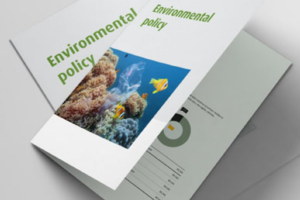Since the rise in our awareness of environmental sustainability, it is more important than ever for companies to engage with their responsibilities towards the environment. An environmental policy should set out the organisation’s approach to managing environmental issues just as they have systems to manage finance, personnel and health and safety. Businesses can use environmental policies as an opportunity to evaluate how their day-to-day activities interact with both the environment and environmental regulations. Companies can use the policy to outline the company’s environmental strategy and motivations for becoming more environmentally friendly. By evaluating daily operatives, businesses are more likely to streamline activities to accommodate legal responsibilities. This often improves energy efficiency and saves the company money.
What does an environmental policy include?
There are no formal requirements on how an environmental policy should be written, but it should be easy to understand. They are usually about a page long. Businesses are encouraged to refer to policies set out by key customers. This way, a business can ensure that their own policies reflect their clients’ requirements.

Before writing an environmental policy, businesses should consider how their activities affect the environment. Companies should reflect on the organisation’s impact on air, water and land pollution and biodiversity. They should also evaluate their waste and ecosystem management, as well as how they aim to protect natural resources, wildlife and endangered species.
The most important features of an environmental policy are time-related targets. These objectives should be supplemented by a measurable management programme, which ensures effective implementation. The policy should be specific and tailored to the organisation and include a commitment for continual improvement. It is also important for the policy to acknowledge and engage with the legal requirements relevant to their activities. A framework for reviewing their objectives and targets should be included.
Customers are interested in:
- What the organisation does and how it does it – do they follow best practice and embrace cleaner production? If so, how?
- Understand whether the organisation is greener or browner than other similar organisations
- Understand whether the organisation presents a direct environmental risk to their operations
- Understand whether the organisation presents a risk to public perception if they are engaged
- Understand whether the organisation has any environmental programs to reduce environmental impact and improve their environmental performance
What does an environmental policy do?
For an environmental policy to be effective, integration into the business is essential. Many businesses even incorporate environmental responsibility into staff inductions and job roles, which improves staff engagement in environmental issues. For an environmental policy to be fully integrated into the daily activities of a business, it should be reviewed regularly. This means that progress and development can be evaluated by managers and affords continual improvement in environmental performance.
An environmental policy makes a business’ commitment to and engagement with their environmental impact and responsibility abundantly clear to all employees. This could be integrated into marketing materials, which may encourage customers and other businesses to adopt similar values. By communicating environmental standards, a business may generate a positive influence as well as increase the amount of custom they attract.


